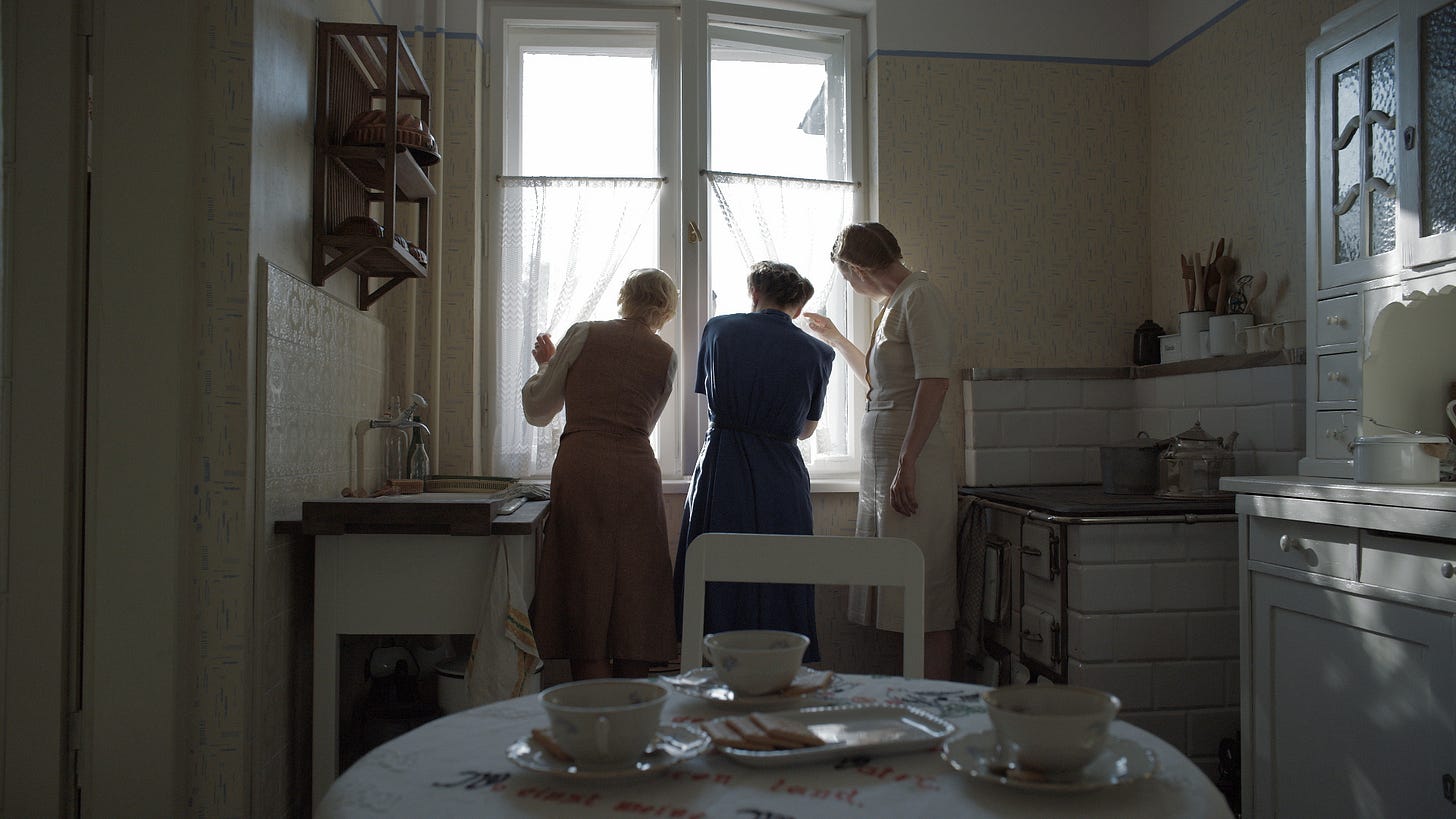I had several films in mind when thinking of how best to kick off a new year of essays here. In fact, I’ve compiled a pretty hefty list of films I’d love to cover. Films I cherish, and others I intend to watch for the first time with the suspicion that they will be perfect to explore in this space. All of those plans were put on hold this week when I finally made it out to see Jonathan Glazer’s The Zone of Interest. A film that completely absorbed me, provoked me, and even now days later seems to demand my full attention.
This is only Jonathan Glazer’s 4th feature-length film, and his first since 2013’s Under The Skin; a film that helped solidify the budding identity of A24, pushed the genres of science fiction and horror in bold new directions, and is an essential entry in the best films of its decade (it’s also a film that will certainly be covered here one day). From his early days directing music videos for Radiohead, Massive Attack, and Blur, Glazer’s oblique yet unflinching sense of style, his willingness to slide into surreality, and his capacity for enticing dread was apparent. He has, since beginning his film career with 2000’s Sexy Beast (a film that might be described as Snatch’s psychologically horrific sibling or In Bruges’ demented pastel godfather) chosen his projects carefully. He is in my mind akin to other such discerning artists like Donna Tartt or Johannes Vermeer. You might not get new work every year, but when you do, it’s not something to be missed.
When I first heard about Glazer’s new subject, a novel of the same name by Martin Amis, I felt both assured and apprehensive. Assured that whatever this film would be, it would be unique and daring. Apprehensive at just how intense it might be, how far it might go. Hundreds of films have taken on the imposing task of translating the horrors of the holocaust to the big screen. Some are better than others. Some contend with this disturbing reality by portraying the atrocities with graphic realism, while others take the form of mournful elegies or heroic epics, and still others approach the material with darkly comic tones. There are many, many films that fall into this canon, but there has never been a film like this.
The Zone of Interest is not the film I expected when I first heard about the project. It’s also not the film I expected after seeing its cryptic trailers, or as I watched it garner five Academy Award nominations including best picture and (most interesting to me before I saw it, but now perfectly understandable) best sound. That this film is in contention for best picture alongside films like Barbie and The Holdovers is quietly one of the most fascinating facts in recent Hollywood memory, because this film is unlike anything else that has been nominated this year. It has no analogue. It’s in a tier all its own.
This film is stunning. Sitting here now, trying to put words to what this film manages to accomplish, I am inspired, invigorated, horrified, but most of all stunned. I also feel helplessly compelled to explore my reaction to this film, which is, as plainly as I can put it, not something to love or enjoy, but something to behold.
The film follows several seasons with Rudolf Höss, his wife Hedwig, and their family whose verdant garden and just-so country style house abuts the walls of Auschwitz. Rudolf, then commandant of history’s most infamous death camp, is a man who loves his job just as Hedwig loves their home. We discover them bathing idly in a river and enjoying a picnic, and once we’ve followed them home and the setting is revealed through subtle yet searingly clear imagery and sound, we can see, without a doubt, that this family is truly happy.
This is not, as you might suspect (as I first suspected), a story of people turning a blind eye to atrocity. It is much more challenging than that. Deeper, and more disturbing. The Zone of Interest is the story of people who have found true human comfort amid atrocity.
This is the horrible truth that Glazer is seeking to expose. Something we know, deep in our bones, but something that is almost too horrible to face. This is not a silver screen recital of mankind’s most heinous crimes. It is instead an unblinking portrait of a home life that is maddeningly banal and sublimely terrible in its authenticity. As this story unfolds, in all of its mundanity and striking familiarity, it is revealed that these people are not at all ignorant of the crimes they perpetrate and permit. They know precisely what is happening on the other side of the garden wall, and there is nowhere else they would rather be.
If I sound a little bombastic here, it’s because it’s difficult to find words for what this film is doing without stumbling into extremity, so I’ll let the filmmakers talk for me:
Glazer knew what a difficult and delicate task this would be, and approaches that task with a reverence and conscientiousness that you can feel in every frame. In an interview with Film at Lincoln Center, Glazer discusses the “considerable apprehension” he experienced when taking on this material. “In cinema it is very easy to glamorize, fetishize, or empower the people who we’re pointing our cameras at, and it was very important to me not to do that.” With this in mind, Glazer stripped the production of the usual cinematic tools. There was no artificial lighting used, none of the cameras were operated in the house (which was constructed from scratch in Poland, not far from the site of the real Höss estate) but instead were positioned or hidden, and microphones were planted allowing for the actors to inhabit scenes unobstructed. These methods lend the film a highly cinematic but decidedly unglamorous visual language and an almost documentary style verisimilitude (barring some sequences that break from this realism in ways I would rather not spoil for those who haven’t seen the film). In any case, the visual world of the film feels both real and unreal, but always staggeringly true.
Actors Christian Friedel and Sandra Huller (who is having one hell of a year between this performance and her nominated turn in Anatomy of a Fall - a portion of which I shouted out in my last post) inhabit these characters with devastating naturalism. Friedel described the approach as “a search.” A search for banality and authenticity that both actors describe as both freeing and frightening to inhabit. “I was full of fear,” Huller says, “and it never really left me.”
But perhaps the most remarkable formal aspect of this film is its use of sound. Sound designer Johnnie Burn created a truly immersive and unnerving layer to the experience of the film. Sounds both organic and inorganic are a constant presence, sometimes indistinct but ubiquitous, and in certain moments crescendo and overwhelm. The soundscape of the film is a work unto itself, one that solidifies the film’s ultimate goal: to feel rather than witness. The victims on the other side of the wall may be out of sight, but they are anything but out of mind as the sounds of the film provoke the imagination in a way that is, perhaps, more powerful than a captured image.
As for what we do see, there is no empathy to be found, but there is terrible recognition. When this family indulges in private jokes, read bedtime stories, or stop on the street to pet a dog that reminds them of a childhood companion, we are faced with a truth more disturbing than monstrosity. We are faced with human beings. The great horror of the holocaust—known but perhaps too often unspoken—is that human beings and human beings alone were its orchestrators, architects, and perpetrators.
“I didn’t want to make a film where we felt this kind of safe distance from these events,” Glazer says. “If we watch a film which is clearly about an event in history—this particular event in history—we can walk away from it with a feeling like ‘well that’s not us, we have no similarities with those perpetrators.’ We really wanted to upend that.”
This shared humanity Glazer seeks to expose will surely unsettle and perhaps rightfully outrage. It’s a little sickening to write about. But it is precisely that outrage that this film so elegantly and richly provokes. An outrage that feels invaluable, awful, and utterly necessary.
This film’s message is ultimately not so much received as inhabited, which is one mark of great art, and its lesson bears repeating endlessly, in myriad forms and with ceaseless urgency. The only way forward is to look dead-on at the worst of what we’ve done and what we’ve been. That is the singular power of The Zone of Interest: its direct, unblinking gaze at the fact that human beings alone are capable of manifesting evil, and that this evil can and has built a comfortable home here on earth, and that the grass there is luscious and hideously green.







